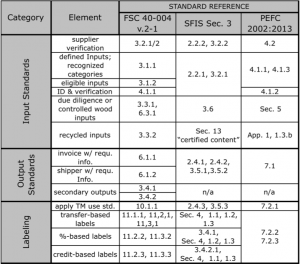In my last post, I introduced some of the basic concepts that define all of our Forest Product Chain of Custody standards – FSC, SFI, and PEFC. In this installment I hope to focus on the key central elements that – in practice – tend to get the most attention and (not coincidently) lead to the most confusion: Inputs, Outputs, and Labels.
Chain of Custody (CoC) is essentially and centrally about traceability. The standards are designed to provide a buyer of a wood-based product (a piece of paper, a wooden chair, etc.) with a credible assurance that it was made from raw materials (i.e. trees) that were grown and harvested in an ethically acceptable way. How to we do this? We do it by communicating the the certified status of a product or material at the time of its sale. A certified landowners sells “certified” trees to a logger. The logger then sells “certified” logs to a pulp mill. The pulp mill sells “certified” pulp to a paper mill. And on and on, until a finished consumer product (e.g. a magazine) with a “green” label ends up on a store shelf. The common language of this communication is defined for us by the PEFC, FSC, & SFI standards. Our use of this language is checked on, and sometimes corrected by, the certification firms (i.e. auditors).
Viewed from the perspective of a CoC-certified company (one link in the supply chain), purchases and sales can be viewed as Inputs and Outputs. One person’s input (or purchase) is, of course, another person’s output (or sale). The three standards attempt to define an acceptable structure and terminology for these processes. In concept, this is quite simple. In practice, it can get a bit confusing.
Input and Output details
At MixedWood, we prefer to work with the three CoC standards in tandem. The table below (click to enlarge it) summarizes the Input, Output, and Labeling requirements of FSC, SFI, & PEFC.
We can break all this down to just a few, key items:
- Supplier Verification: this requirement is among the most consistent and clear in all three systems. Before you buy a “certified” product, you are required to verify that your supplier holds a valid certificate. Oddly, none of the standards specify how often to do this verification. I recommend updating it at least annually.
- Terminology & Eligible Inputs: this group of requirements is less clear and less consistent. FSC provides us with some very specific requirements to use their terminology, which is (unfortunately) less clear than it ought to be. PEFC provides a pretty straightforward balance of clear terminology and flexible requirements. SFI, on the other hand, is a confused muddle: with very open-ended requirements and complex and badly-defined categories.
- Identification and Receipt: all three standards require that companies formally verify their certified inputs. FSC’s requirements are generally considered overly detailed and often troublesome in practice. SFI requirements include so much flexibility as to create confusion and misunderstanding. PEFC strikes a good balance. This is where we look carefully at the invoice (or packing list) for magic words like “FSC Recycled Credit” and where the difference between “Mix” and “Mixed” can become important.
- Non-certified Inputs: all three standards include input standards for material types which are not certified, but nonetheless acceptable in some way. This includes recycled materials – which are recognized as desirable by all three programs. It also includes reference to Due Diligence and Controlled Sourcing requirements. We’ll deal separately with these in a future article.
- Output standards: ideally, the standard requirements for output should work in concert with the input requirements. PEFC has the best and simplest approach to this. FSC is somewhat more complex (as usual) but generally works in practice. SFI suffers from a frustrating combination of simple and flexible performance standards, combined with obscure and confusing claim terminology.
Labeling
When considering the labeling standards, there are 2 rules that always apply:
- Labeling is always optional.
- Labeling and Claims must be consistent.
Applying these rules will keep you out of trouble 90% of the time. And the person who approves your label (whether they work for SFI or your certifier) will not be able to help you with either of them.
As to the details, similar rules of thumb apply. FSC labeling details dominate the business. Their standards are overly complex, but manageable. Not many US companies apply PEFC labels. Those that do find the process pretty straightforward. SFI labeling is (sadly) still a confused mess. Their labeling rules are probably the most transparent, but are very often mis-applied. We hope to see improvements in the standard updates this year.
The Bottom Line
The CoC requirements summarized here are only a small part of the standards. But they address the “heart and soul” of what CoC is all about and are where we find most of the mistakes, confusions, and mis-applications out in the real world. The secret is this: figure out the common language of your chosen CoC program. Use it carefully and consistently with your customers. Insist on its use with your suppliers. With a little persistence, things will begin to fall into place. The best news is that when you get your Inputs and Outputs straight – and avoid problems with your Labeling – everything else is easy. And that is the way it should be, because….CoC SHOULD BE EASY!
More to come
Watch this space for more installments to this series in the coming weeks. Use the comment box below to provide feedback, questions, ideas, etc.
